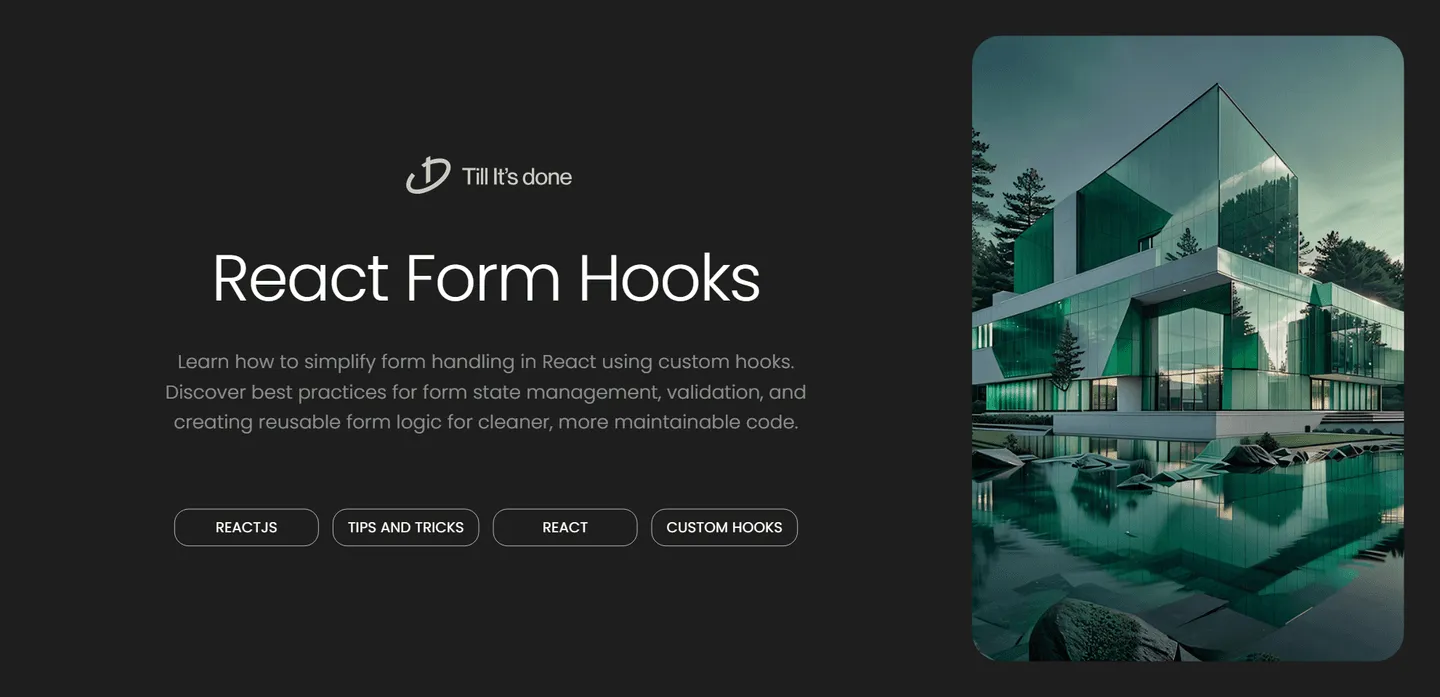- Services
- Case Studies
- Technologies
- NextJs development
- Flutter development
- NodeJs development
- ReactJs development
- About
- Contact
- Tools
- Blogs
- FAQ
Manage Forms in React with Custom Hooks Guide
Discover best practices for form state management, validation, and creating reusable form logic for cleaner, more maintainable code.

How to Manage Forms Effectively in React with Custom Hooks

Managing forms in React can be tricky. While the framework gives us powerful tools to handle user input, dealing with form state, validation, and submission can quickly become messy. But fear not! In this guide, I’ll show you how to create elegant, reusable form management solutions using custom hooks.
The Problem with Traditional Form Handling
We’ve all been there - managing multiple input fields, handling validation, tracking touched/dirty states, and coordinating form submission. What starts as a simple form can quickly spiral into a complex maze of state management and event handlers.
Consider this common scenario:
function SimpleForm() { const [email, setEmail] = useState(''); const [password, setPassword] = useState(''); const [errors, setErrors] = useState({}); const [isSubmitting, setIsSubmitting] = useState(false);
// Imagine adding more fields... it gets messy quickly!}
Enter Custom Form Hooks
Custom hooks let us extract and reuse form logic while keeping our components clean and focused. Let’s build a powerful custom form hook:
function useForm(initialValues, validate) { const [values, setValues] = useState(initialValues); const [errors, setErrors] = useState({}); const [touched, setTouched] = useState({}); const [isSubmitting, setIsSubmitting] = useState(false);
const handleChange = (e) => { const { name, value } = e.target; setValues(prev => ({ ...prev, [name]: value })); };
const handleBlur = (e) => { const { name } = e.target; setTouched(prev => ({ ...prev, [name]: true })); };
// More logic here...}Putting It All Together
Here’s how we can use our custom hook to create a clean, maintainable form:
function LoginForm() { const { values, errors, touched, handleChange, handleBlur, handleSubmit } = useForm( { email: '', password: '' }, validateLoginForm );
return ( <form onSubmit={handleSubmit}> {/* Form fields here */} </form> );}
Advanced Features
Our custom hook can be extended with powerful features:
- Field-level validation
- Form-wide validation
- Submission handling
- Async validation
- Error message formatting
- Custom input types support
Best Practices
- Keep validation logic separate from the form hook
- Use TypeScript for better type safety
- Implement debouncing for real-time validation
- Add loading states for async operations
- Include error boundary handling
Conclusion
Custom hooks transform form management from a necessary evil into a streamlined, maintainable solution. They encapsulate complex logic while providing a clean API for components to use.
Remember, the goal is to write code that’s not just functional, but maintainable and scalable. Custom hooks help us achieve exactly that.

 สร้างเว็บไซต์ 1 เว็บ ต้องใช้งบเท่าไหร่? เจาะลึกทุกองค์ประกอบ website development cost อยากสร้างเว็บไซต์แต่ไม่มั่นใจในเรื่องของงบประมาณ อ่านสรุปเจาะลึกตั้งแต่ดีไซน์, ฟังก์ชัน และการดูแล พร้อมตัวอย่างงบจริงจาก Till it’s done ที่แผนชัด งบไม่บานปลายแน่นอน
สร้างเว็บไซต์ 1 เว็บ ต้องใช้งบเท่าไหร่? เจาะลึกทุกองค์ประกอบ website development cost อยากสร้างเว็บไซต์แต่ไม่มั่นใจในเรื่องของงบประมาณ อ่านสรุปเจาะลึกตั้งแต่ดีไซน์, ฟังก์ชัน และการดูแล พร้อมตัวอย่างงบจริงจาก Till it’s done ที่แผนชัด งบไม่บานปลายแน่นอน  Next.js สอน 14 ขั้นตอนเบื้องต้น: สร้างโปรเจกต์แรกใน 30 นาที เริ่มต้นกับ Next.js ใน 14 ขั้นตอนเพียงแค่ 30 นาที พร้อม SSR/SSG และ API Routes ด้วยตัวอย่างโค้ดง่าย ๆ อ่านต่อเพื่อสร้างโปรเจ็กต์แรกได้ทันทีที่นี่
Next.js สอน 14 ขั้นตอนเบื้องต้น: สร้างโปรเจกต์แรกใน 30 นาที เริ่มต้นกับ Next.js ใน 14 ขั้นตอนเพียงแค่ 30 นาที พร้อม SSR/SSG และ API Routes ด้วยตัวอย่างโค้ดง่าย ๆ อ่านต่อเพื่อสร้างโปรเจ็กต์แรกได้ทันทีที่นี่  วิธีสมัคร Apple Developer Account เพื่อนำแอปขึ้น App Store ทีละขั้นตอน อยากปล่อยแอปบน App Store ระดับโลก มาอ่านคู่มือสมัคร Apple Developer Account พร้อมเคล็ดลับ TestFlight และวิธีอัปโหลดที่ง่ายในบทความเดียวนี้ได้เลย
วิธีสมัคร Apple Developer Account เพื่อนำแอปขึ้น App Store ทีละขั้นตอน อยากปล่อยแอปบน App Store ระดับโลก มาอ่านคู่มือสมัคร Apple Developer Account พร้อมเคล็ดลับ TestFlight และวิธีอัปโหลดที่ง่ายในบทความเดียวนี้ได้เลย  TypeScript Interface คืออะไร? อธิบายพร้อมวิธีใช้และข้อแตกต่างจาก Type เรียนรู้วิธีใช้ TypeScript Interface เพื่อสร้างโครงสร้างข้อมูลที่ปลอดภัยและเข้าใจง่าย พร้อมเปรียบเทียบข้อดีข้อแตกต่างกับ Type ที่คุณต้องรู้ ถูกรวมเอาไว้ในบทความนี้แล้ว
TypeScript Interface คืออะไร? อธิบายพร้อมวิธีใช้และข้อแตกต่างจาก Type เรียนรู้วิธีใช้ TypeScript Interface เพื่อสร้างโครงสร้างข้อมูลที่ปลอดภัยและเข้าใจง่าย พร้อมเปรียบเทียบข้อดีข้อแตกต่างกับ Type ที่คุณต้องรู้ ถูกรวมเอาไว้ในบทความนี้แล้ว  Material-UI (MUI) คืออะไร อยากสร้าง UI สวยงามและเป็นมืออาชีพในเวลาอันรวดเร็วใช่ไหม มาทำความรู้จักกับ Material-UI (MUI) ที่ช่วยให้คุณพัฒนาแอปพลิเคชันบน React ได้ง่ายและดูดีในทุกอุปกรณ์
Material-UI (MUI) คืออะไร อยากสร้าง UI สวยงามและเป็นมืออาชีพในเวลาอันรวดเร็วใช่ไหม มาทำความรู้จักกับ Material-UI (MUI) ที่ช่วยให้คุณพัฒนาแอปพลิเคชันบน React ได้ง่ายและดูดีในทุกอุปกรณ์  เปรียบเทียบ 3 วิธีติดตั้ง install node js บน Ubuntu: NVM vs NodeSource vs Official Repo แบบไหนดีที่สุด? เรียนรู้วิธีติดตั้ง Node.js บน Ubuntu ด้วย NVM, NodeSource หรือ Official Repo เลือกวิธีที่เหมาะกับความต้องการของคุณ พร้อมเปรียบเทียบ เพื่อการพัฒนาที่มีประสิทธิภาพ!
เปรียบเทียบ 3 วิธีติดตั้ง install node js บน Ubuntu: NVM vs NodeSource vs Official Repo แบบไหนดีที่สุด? เรียนรู้วิธีติดตั้ง Node.js บน Ubuntu ด้วย NVM, NodeSource หรือ Official Repo เลือกวิธีที่เหมาะกับความต้องการของคุณ พร้อมเปรียบเทียบ เพื่อการพัฒนาที่มีประสิทธิภาพ! พูดคุยกับซีอีโอ
We'll be right here with you every step of the way.
We'll be here, prepared to commence this promising collaboration.
Whether you're curious about features, warranties, or shopping policies, we provide comprehensive answers to assist you.


